July 5, 2019
Air Date: July 5, 2019
FULL SHOW
SEGMENTS
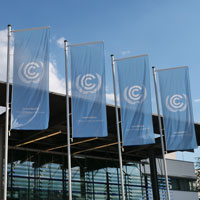
US Blocks UN and G20 Climate Action
View the page for this story
June 2019 brought world leaders together at two major meetings: the Bonn Climate Conference and the G20 Osaka Summit. Negotiators in Bonn continued their work on hammering out the details of the landmark Paris Climate Agreement. But although much stronger commitments under the Paris Agreement are needed, major polluters have yet to step forward with promises to further curb emissions, and the US is opposed. The US also blocked climate action at the G20 meeting in Osaka. Alden Meyer, Director of Strategy and Policy for the Union of Concerned Scientists, joins Host Steve Curwood to sort through the major takeaways from these meetings. (06:52)
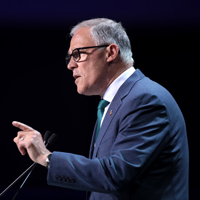
Not Much Presidential Debate About Climate
/ Peter DykstaView the page for this story
This week, Peter Dykstra joins Host Steve Curwood to talk about how climate change, a key concern these days for Democratic voters, fared in the first series of Democratic debates held on 2 consecutive nights. To the dismay of some candidates and activists, climate change received just 15 minutes in 4 hours, and half of the 20 candidates onstage did not say anything about climate at all. Now the Democratic National Committee appears to be reconsidering its refusal to hold a dedicated climate change debate. (05:08)
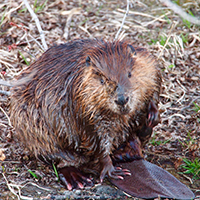
USDA Kills Thousands of Beavers
View the page for this story
Every year, an arm of the US Department of Agriculture called Wildlife Services kills millions of native species, including gray wolves, coyotes, beavers, prairie dogs, and even red-winged blackbirds. Now the Center for Biological Diversity is bringing an Endangered Species Act lawsuit against Wildlife Services over its shooting and trapping of more than a thousand beavers in California every year. Collette Adkins, a senior attorney with the Center for Biological Diversity, joined Host Steve Curwood to explain why Wildlife Services’ program of beaver-killing is harming endangered salmon and steelhead in California that depend on beaver-created habitats. (07:59)
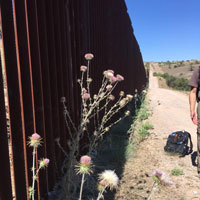
Science at Risk at the Border
/ Bobby BascombView the page for this story
Scientists working on the US-Mexico border face unique challenges when trying to study borderlands ecosystems, thanks to everything from outright harassment at the hands of Border Patrol officers, to tight restrictions on what natural materials can cross the border. They say it’s gotten much worse in recent years since the Trump Administration began advocating for a massive border wall as well as taking a hard line on illegal immigration and asylum seekers. Living on Earth's Bobby Bascomb is producing a series of dispatches from the US-Mexico border and discusses the challenges of doing science on the border with Host Steve Curwood. (11:02)
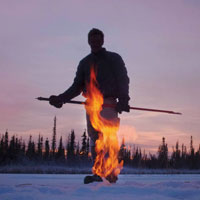
HBO’s “Ice on Fire” Offers Climate Solutions
View the page for this story
The Earth is warming and changing faster than many climate scientists had predicted, and at times the future looks impossibly grim. Yet practical and accessible solutions to climate change are already at hand. The new HBO documentary “Ice on Fire”, produced and narrated by Leonardo DiCaprio, focuses on these solutions as well as the dangers and on the scientists who are tackling climate change. Director Leila Conners joined Host Steve Curwood to discuss the making of the documentary and who it aims to reach. (15:03)
Show Credits and Funders
Show Transcript
HOST: Steve Curwood
GUESTS: Collette Adkins, Leila Conners, Alden Meyer
REPORTERS: Bobby Bascomb, Peter Dykstra
[THEME]
CURWOOD: From Public Radio International – this is Living On Earth.
[THEME]
CURWOOD: I’m Steve Curwood.
At the recent UN climate session in Bonn, Germany, and the G20 summit in Japan, the US was a lonely voice saying no to climate action.
MEYER: It was very clear the United States was not willing to sign onto anything which mentioned the Paris agreement, the need for deep decarbonization, the urgency of action on climate change, and the other 19 countries indicated that for them, Paris remains irreversible and they intend to go ahead.
CURWOOD: Also a new climate documentary that has some good news.
HAWKEN: Where do we stand? Is it possible? Is it game over, or is it, in fact, game on? Which is, that we have, at hand, the ability, capacity, and solutions that can reverse global warming. Not mitigate, not reduce, not stabilize ...but reverse…
CURWOOD: We’ll have those stories and more this week on Living on Earth – stick around!
[NEWSBREAK MUSIC: Boards Of Canada “Zoetrope” from “In A Beautiful Place Out In The Country” (Warp Records 2000)]
[THEME]
US Blocks UN and G20 Climate Action
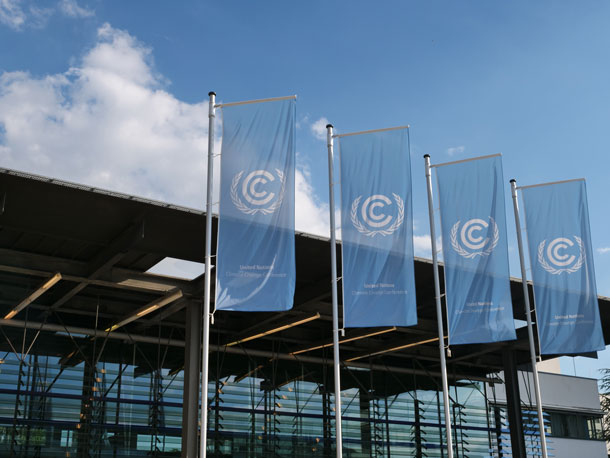
Thousands of delegates from around the world met for two weeks for the Bonn Climate Change Conference in order to discuss the details of the Paris Agreement. (Photo: German Development Institute, Flickr, CC BY-ND 2.0)
CURWOOD: From PRI and the Jennifer and Ted Stanley Studios at the University of Massachusetts Boston, this is Living on Earth. I’m Steve Curwood.
Disruption of the climate seems to be advancing quickly. Mexico just had a freak storm with waist-deep hail in Guadalajara. Not long ago Mumbai, India shut down trains in many parts of the city, when months worth of rain fell in just two days, and since March, Southeast Africa has suffered two record-breaking cyclones. But in Europe, where France was just scorched by a 115 degree heat wave, climate protection negotiators in Bonn, Germany recently worked at a rather glacial pace to flesh out the mechanisms of the Paris Climate Agreement. At the G20 meeting in Japan, the US blocked consensus on climate action. Alden Meyer, director of strategy and policy for the Union of Concerned Scientists just returned from Bonn and has an update. Hi, Alden, welcome back to Living on Earth.
MEYER: Good to be with you again, Steve.
CURWOOD: So there were, what, 2,000 delegates there in Bonn at this latest round of climate talks. What got accomplished?
MEYER: Well, this was really preparing the way for COP25, the 25th Conference of the Parties meeting in Santiago, Chile. So they were focusing on decisions that they would be forwarding for consideration by that summit. The big unfinished piece of business coming out of the Katowice, Poland summit last year was article six of the Paris Agreement, which is the so-called market mechanisms. Can countries cooperate with each other to meet the pledges they put forward to reduce their emissions under the Paris Agreement? It was very intense, they did succeed in sort of expanding the negotiating text, getting everyone's ideas in the mix, on the table. But they did not make much progress on closing any of the deep divisions over ways to ensure that any market mechanisms work for the benefit of the environment, not just to reduce costs to a million countries, but actually contribute to raising ambition. So that was one of the issues. They're hoping to wrap that up in Santiago in December. But I think that's going to be a very heavy lift, to bridge the deep divisions there and finish that one remaining piece of the Paris rule book.
CURWOOD: What about the question of loss and damage? That is, that the less developed countries are having to cope with the effects of climate disruption?
MEYER: Well, that's going to be a big issue in Santiago this December at the next climate summit meeting. What they were doing in Bonn is framing what's called the terms of reference for how they're going to conduct that discussion. What's on the table? Is it just backward-looking at how they've done since the loss and damage mechanism was set up six years ago at the COP in Warsaw? Or are they going to look forward? And especially are they going to look at ways to mobilize more financial support for countries that are struggling to cope with the mounting impacts of climate change over the next several decades? So we need to address this issue. It's a very intense issue, and countries like the US are ferociously resisting any meaningful discussion of expanding financial resources for loss and damage.
CURWOOD: So, Alden, there's another meeting of world leaders in New York this September, what's that summit all about? And how is that different from the Climate Summit?
MEYER: Well, that is the United Nations Secretary General Antonio Guterres, who has called for world leaders to come to a one day event in New York during the opening of the United Nations General Assembly, it's going to be on September 23. And the explicit focus of that meeting is to raise ambition, particularly to hear from countries how they plan to increase their current commitments and pledges under Paris, because all the analysis shows that even if countries carry out the commitments they've made, they only get us about one third of the way towards the emissions reductions by 2030 that we need to have any chance at holding temperature increases below two degrees Celsius. So he's called this summit. It's not a one-day event, he wants to have follow up for this. So there will be a discussion of it in Santiago, three months later. And of course, this is all aimed at the next Conference of the Parties meeting, which will be at the end of 2020, which is the real deadline for countries to give their final answer about whether they're prepared to raise the ambition of their current commitments under Paris. So this is going to be a very high profile moment. That's the good news. The bad news is we're not yet clear what the major emitting countries are going to be willing to bring to the table. So far, none of the big players are willing to formally say they will increase their commitments. So that is going to be the task before us, not only in the lead up to the summit, but for the rest of this year and going into next year.
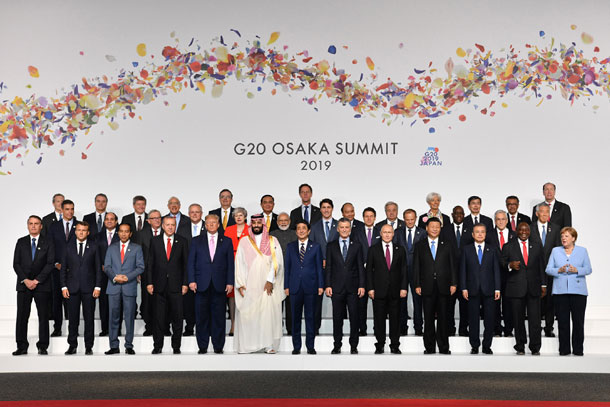
World leaders from 19 countries and the European Union met in Osaka, where all but the United States reaffirmed their commitment to the Paris Agreement. (Photo: G20 Osaka, Flickr, CC BY-NC 2.0)
CURWOOD: And speaking of summits, we just saw the G20 summit wrap up, in Japan. How did the climate fare at that summit?
MEYER: Well, it was a very intense discussion. The Japanese hosts of the meeting were desperately trying to find a consensus between the 19 countries that are still in the Paris Agreement and the United States which has said it intends to withdraw. And that is causing deep divisions. Despite the Japanese effort to get consensus, it was very clear the United States was not willing to sign on to anything which mentioned the Paris Agreement, the need for deep decarbonization, the urgency of action on climate change. So what happened is what happened at the last two summits in Germany and Argentina, where they had a separate paragraph for the United States explaining that it is not in the Paris Agreement, does not intend to meet its Paris commitments, and why. And the other 19 countries indicated that for them, Paris remains irreversible and they intend to go ahead.
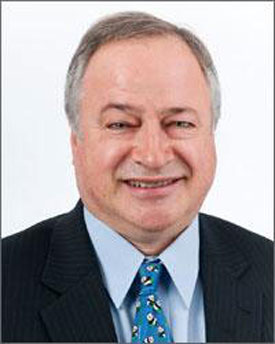
Alden Meyer is director of strategy and policy for the Union of Concerned Scientists. (Photo: Union of Concerned Scientists)
CURWOOD: How depressed are you about all this?
MEYER: Well, I'm obviously depressed that we're not getting a better response from political leaders. The impacts are very clear, more and more people are out in the streets, but I think you're seeing the power of the fossil fuel industry. The power of inertia and vested interest in a number of these countries that are really slowing down the response that we should see. There are some bright spots, however; just in the last month, the United Kingdom has formally declared a climate emergency and has adopted a 100% reduction going for net zero by 2050. In the second week of Bonn, the new government in Denmark announced that it would be putting in place a plan to cut emissions 70% by 2030. I think that's the most ambitious reduction target I've heard from either national or sub national governments. So there are some good signs here but we're not moving at anywhere near the pace that we need to head off truly devastating impacts of climate change. And that is depressing.
CURWOOD: Alden Meyer is director of strategy and policy for the Union of Concerned Scientists.
Related links:
- Union of Concerned Scientists | “Bonn Climate Talks Make Limited Progress, Greater Political Leadership Essential to Address Climate Emergency”
- See more from the June 2019 Bonn Climate Change Conference here
- Reuters | “U.S. Remains Outlier As G20 Split Over Tackling Climate Change”
- Find out more about the UN Climate Action Summit 2019
Not Much Presidential Debate About Climate

Washington Governor Jay Inslee is the only current Democratic presidential candidate whose major political platform is focused on climate change. (Photo: Gage Skidmore, Wikimedia Commons, Gage Skidmore from Peoria, AZ, United States of America, CC BY-SA 2.0)
CURWOOD: For a look at how the Democratic candidates for president here in the United States debated over climate action, we turn now to Peter Dykstra. He's an editor with Environmental Health News, that’s EHN.org and DailyClimate.org. Peter's on the line now from Atlanta. Hi there, Peter!
DYKSTRA: Hi, Steve.
CURWOOD: So, Peter, 20 of the Democratic contenders for the White House recently appeared in back to back debates of 10 each, hosted by NBC and MSNBC. And, polling suggests a large majority of likely Democratic primary voters are concerned, if not outright alarmed by climate disruption, but I'm not sure they got a whole lot to go on from these debates. What do you think?
DYKSTRA: I think you're right. The differences between that huge number of candidates on climate change and environment are minor when you compare those differences to the differences between any of them as an opponent next year to President Trump.
CURWOOD: So, we haven't heard much about climate in presidential debates for a while. Right?
DYKSTRA: Right. In the final debates, the Republican nominee versus Democratic nominee, we haven't had a question asked about climate change since 2008, when the moderator bungled the question, and Senator McCain and Senator Obama both kind of avoided the answer and talked about energy independence, instead of climate change.
CURWOOD: How much time was devoted over the four hours of the two debates to climate disruption?
DYKSTRA: 15 minutes out of four hours. One night for eight minutes, one night for seven minutes.

The democratic debates were held over two nights to accommodate the 20 Democratic presidential candidates. (Photo: MSNBC on Twitter | @NBCNews)
CURWOOD: I mean, there were 20 people involved, that's not exactly a whole lot of room.
DYKSTRA: About half of them didn't get to say anything at all about climate change.
CURWOOD: So what about the ones that did?
DYKSTRA: The ones that did, the questions were not so hot, and that's been pointed out in a lot of different places. 10 of the candidates were asked about the biggest geopolitical threat. Four of the 10 said it was climate change, which to me means six of the 10 didn't say it was climate change. Then you've got Governor Jay Inslee of Washington State, you had him on the program here several weeks ago, the fact that he has identified climate change as his signature issue, as the reason he's running for president was treated almost like a novelty in these debates, and maybe elsewhere in coverage of the campaign.
CURWOOD: Yeah, sure gave me the impression as I was watching that, they said, ‘Well, now Governor Inslee we're going to give you something that you really like.’ But that they were like, pigeonholing him on this question, and said, 'Hey, go climb into that pigeonhole.'
DYKSTRA: Yeah, he's focusing on the existential threat of the 21st century. And, isn't that adorable?
CURWOOD: [LAUGHS] Indeed. So, even though majority of Democrats say they care about climate change, they care about it less than...?
DYKSTRA: Less than guns, less than terrorism, less than the economy, less than immigration, less than health care, and probably a few other things thrown in there.
CURWOOD: What is it about American politics that climate change as a subject is really constipated in our political process right now?
DYKSTRA: Well, this is something that's not absolutely unique to America, but it's a stronger and more negative force in this country than anywhere else in the world. And, that's that we pose climate change as a left versus right, Republican versus Democrat, conservative versus liberal issue. It shouldn't be that, and as long as it's that, it's going to be viewed as a political issue, not a science based crisis.
CURWOOD: What's the problem here? I mean, today, for example, the United States is the world's largest producer of oil and gas. And, obviously, that has an impact among Republicans. But what kind of impact do you think it has among the Democrats?
DYKSTRA: It's hard to say what that impact is. I think the big impact that's right in front of us is that climate change still isn't polling well with the public. That's a chicken or egg thing. Is the public not sufficiently alarmed about the potential damage of climate change because it's not covered in the media? Or is the media not covering it because the public isn't sufficiently alarmed?

Out of four total hours of debate, only about 15 minutes were spent discussing topics related to climate change. (Photo: MSNBC on Twitter | @NBCNews)
CURWOOD: There's been quite an outcry among some of the Democratic candidates and activists that the Democratic Party should have a debate devoted to the climate. You know, given the paucity of discussion in this last set of debates, they have something of a case. And I gather, there's been some movement on this subject, that the Democratic National Committee, which has said no to the process, maybe moving more towards maybe?
DYKSTRA: Yeah, it's definitely maybe right now, as of this past week. The Democratic National Committee has responded to a lot of the complaints and displeasure that climate change did not rate its own debate by keeping the issue open. They're going to meet again in August and possibly at that time, they may decide whether to hold an exclusive debate that just focuses on climate change. They've got close to a year to put that one on. So time certainly isn't an issue. But the will to make this as big an issue as many of us think that it is, is still open to question.
CURWOOD: Thanks, Peter. Peter Dykstra is an editor with Environmental Health News. That's EHN.org and DailyClimate.org. We'll talk to you again real soon.
DYKSTRA: Okay, Steve, thanks a lot. We'll talk to you soon.
CURWOOD: And, there's more on the Democratic Party debate about climate change on the Living on Earth website, LOE.org.
Related links:
- The Washington Post | “The Energy 202: DNC will consider holding a climate debate amid protests”
- The New York Times | "Who's Running for President in 2020?"
[MUSIC: Champion Jack Dupree, “Give Me the Flowers While I’m Livin’” on Deep Blue: 25 Years of Blues]
CURWOOD: Coming up – according to the US government, beavers in California are the enemy. That’s just ahead on Living on Earth. Keep listening!
ANNOUNCER: Support for Living on Earth comes from Sailors for the Sea and Oceana. Helping boaters race clean, sail green and protect the seas they love. More information at SailorsForTheSea.org.
[CUTAWAY MUSIC: Professor Longhair, “501 Boogie” on Deep Blue: 25 Years of Blues Music on Rounder Records, by Roy Bird, Rounder Records]
USDA Kills Thousands of Beavers

Beavers sometimes damage trees and cause flooding, but there are nonlethal methods for addressing beaver-human conflicts. (Photo: ramendan, Flickr CC BY-ND 2.0)
CURWOOD: It’s Living on Earth, I’m Steve Curwood.
Just ahead, along with the human tragedy that is unfolding along the US-Mexico border there is another casualty, truth in the form of open scientific research. But first we turn to Collette Adkins of the Center for Biological Diversity. Ms. Adkins is here to explain why her organization is bringing legal action under the Endangered Species Act against the Wildlife Services division of the US Department of Agriculture, in a bid to halt killing of thousands of beavers in California.
ADKINS: So the first question is, how are we using the Endangered Species Act to protect beaver, which are of course not endangered, although they are facing declines. Well, it's because of this connection between beaver and endangered wildlife. So, if we take salmon as an example, now these are endangered fish that absolutely require beaver habitats to survive. And we're seeing these huge declines of salmon and steelhead almost everywhere that they live. And in places where we don't have beaver, people actually go out and try to recreate these ideal habitats the beavers create for us for free! These ponds and these dams that allow the salmon to live there with cover, and food. So what we hope to accomplish through this lawsuit is this analysis that the Endangered Species Act requires, to look at how killing beaver could harm endangered wildlife, and then to take common sense measures to prevent that harm. So for example, in places that have been designated as critical habitat for endangered wildlife, to bar Wildlife Services from killing beaver in those areas, and instead require the program to use non-lethal methods.
CURWOOD: I understand the Center for Biological Diversity took similar legal steps in Oregon a couple of years ago. What happened as a result of that?
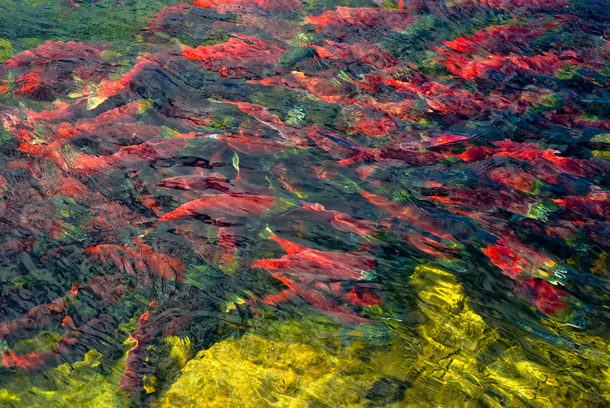
By engineering small dams that store water, beavers provide crucial habitat for endangered salmon and other native species. (Photo: KSI Photography, Flickr CC BY-NC-ND 2.0)
ADKINS: Yes, back in 2017, we filed a Notice of Intent to sue Wildlife Services in Oregon. They ultimately agreed to temporarily shut down their program of killing aquatic mammals, not only beaver, but mink, muskrat, and otter. Because of that lawsuit, we've saved hundreds of these important animals. It's something that I'm really proud of.
CURWOOD: By the way, what are some of the non-lethal methods for reducing conflicts between people and beavers?
ADKINS: So, beaver sometimes take down trees that people don't want to have killed, like in a parkland, for example. Well, those trees can just be wrapped at the base with a barrier. Or if there's an area that you don't want to have flooded by beaver activity, there's these culverts that can be installed in the beaver dam, these flow devices, basically, that allow the beavers to perform their roles in nature without being killed, but still prevent the conflict. And what's nice about those non-lethal methods is that they're long-term. Just killing a beaver because it's causing a conflict is just a band-aid solution; temporary, because soon enough, another beaver will move into that area, and the same problems will be caused again. And then we have this ongoing just cycle of killing and killing, year after year. But if you put in these preventative measures, it's just a one-time fix. And then the beaver can be happy and so can the landowner.
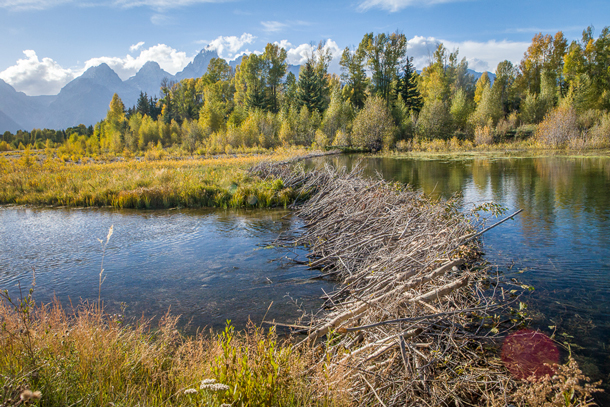
Beaver dams significantly slow the water in a stream and help create lush landscapes. (Photo: Fred Dunn, Flickr CC BY-NC 2.0)
CURWOOD: Collette, as I understand it, the beaver killing is just a slice of what the Agricultural Department's Wildlife Services does in terms of killing animals. How extensive is that role in terms of killing animals?
ADKINS: If we just take a look at data from last year, more than 1.5 million native animals, more than 68,000 coyotes, 22,000 beaver, more than half a million red-winged blackbirds, and lots and lots of animals that I just can't even fathom are causing any trouble, like chickadees, robins, owls, even animals like turtles and lizards; there are so many species that are targeted and killed by Wildlife Services, and then so many others that are just caught in the crosshairs. Caught by these indiscriminate traps and snares that maybe Wildlife Services might put down to catch a coyote, but then catch an endangered wolf instead. Or put down a snare to catch, you know, like a muskrat and then catch a beaver instead. These methods are indiscriminate. And really, we just can't be using them anymore.
CURWOOD: How cruel are the methods that Wildlife Services operators use?
ADKINS: When you think about painful leg-hold traps, that are banned as inhumane in numerous countries, and in numerous states here in the US; strangulation snares; poisons. They're extremely cruel. You think about the awfulness that one individual animal might suffer when caught for days in a leg-hold trap. You hear the -- oh, just the horrible stories of an animal chewing on its own limb, with broken teeth and frostbite from being out in the cold. And then multiply that by the millions of animals that are targeted by Wildlife Services. It's absolutely heartbreaking.
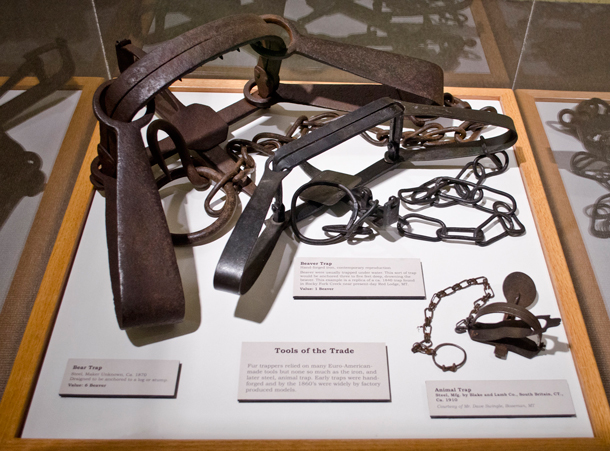
Steel-jaw traps on display in the Museum of the Rockies in Bozeman, Montana. These types of traps, which some consider inhumane because they can inflict pain and serious injury, have been banned in several states and more than a hundred countries. (Photo: Tim Evanson, Flickr CC BY-SA 2.0)
CURWOOD: What's next for the Center for Biological Diversity in this movement? You've, first you targeted Oregon on this question of beavers; now you're targeting California. Where's next?
ADKINS: We're looking across the country to find different places where endangered wildlife rely on habitats created by beaver. We're hoping that because of success in Oregon, and hopefully some success soon in California, we can just get this policy change in place across the country with Wildlife Services. There's other things that we're working on too, to rein in this agency. We're trying to target some of the most indiscriminate and ecologically harmful methods that they use. So for example, M-44 cyanide bombs are these cartridges that are pounded into the ground, baited with this smelly substance that attracts wolves and coyotes. But anything that pulls on the device is shot with this deadly sodium cyanide spray. Just a couple years ago, a teenage boy reached down and touched one on public land behind his house. He was temporarily blinded, his dog died a terrible, inhumane death right in front of his eyes. There's, every year, a handful of instances where beloved family animals are killed by these devices. We're trying to get a federal ban on them. What we want to have done is to make this agency really match the values and the science that we have today. We know that there are more effective ways to deal with conflicts with wildlife than simply killing them. And this agency could do a lot of good by helping ranchers, for example, deal with coyotes that might target their livestock, helping them put in guard dogs or fencing, or motion sensing lights that would scare away these canids. But instead they just keep turning back to these decades-old methods that are expensive, indiscriminate and cruel. And we hope that through our campaign over time, and we know it will be a long battle, we'll be able to get this change in the agency.
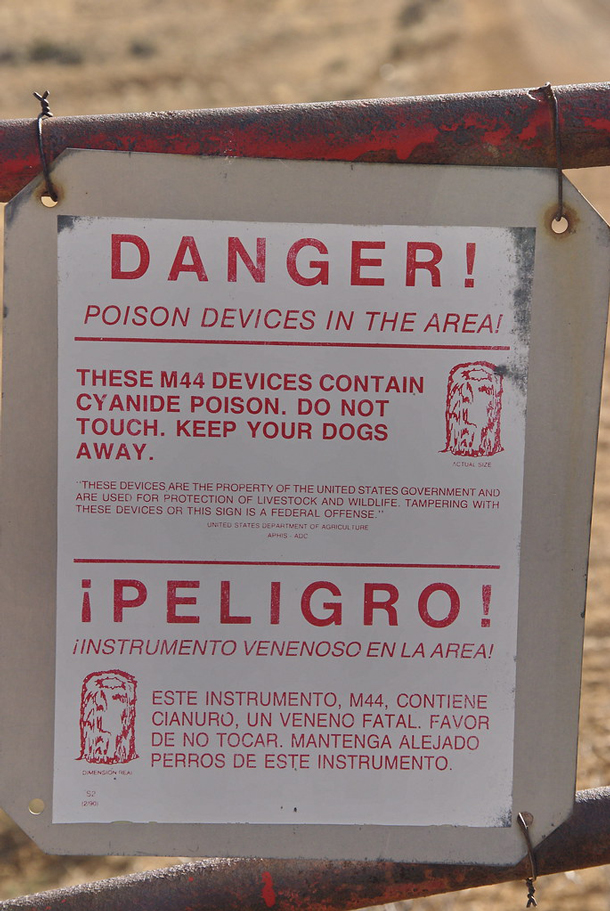
A sign warns about M44 cyanide poison devices, commonly used by Wildlife Services to kill coyotes. (Photo: killbox, Flickr CC BY-NC 2.0)
CURWOOD: Collette Adkins is a senior attorney with the Center for Biological Diversity. Thanks so much for taking the time with us today.
ADKINS: Oh, thanks so much for having me.
CURWOOD: The USDA declined to comment on ongoing litigation, but said “Staff give preference to nonlethal methods when practical and effective.” We’ll post the full statement on our website at LOE.org.
Statement from USDA – Animal and Plant Health Inspection Service (APHIS) on Wildlife Services
"USDA, Animal and Plant Health Inspection Services, Wildlife Services does not conduct animal or pest control. Rather, upon request, it provides assistance with conflicts between humans and wildlife. Such assistance can include managing conflicts with beavers. Pursuant to Wildlife Services Directive 2.101, staff give preference to nonlethal methods when practical and effective. Nonlethal options for beaver damage management are described in the linked factsheet Beaver Damage Management factsheet. Additional information is available in the linked publication: Beaver, Wildlife Damage Management Technical Series. Wildlife Services’ beaver damage management activities include requests for assistance to benefit and protect native threatened and endangered species.
"For funding questions, please refer to Wildlife Services’ Program Data Reports. PDR A details the types of resources protected (agriculture, property, natural resources, and human health/safety) and the source of funding nationally and by state.
"APHIS will not comment on prospective litigation."
Related links:
- Center for Biological Diversity press release about the lawsuit in California
- Notice of Intent to Sue Wildlife Services over beaver killing in California
- Wildlife Services agreed to stop killing beavers in Oregon in 2018
[MUSIC: Mark Howard/Tim Crouch/Stuart Duncan, “Don’t Fence Me In” on Cowboy Roundup, by Cole Porter, Cumberland Records]
Science at Risk at the Border
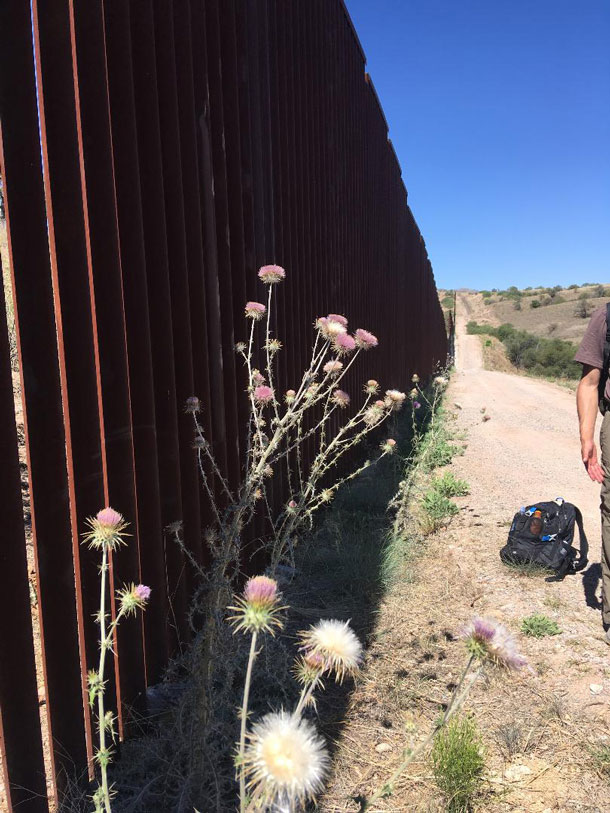
The border between the United States and Mexico is among the most heavily guarded in the world, causing complications for the nature that exists there, as well as the scientists that study that nature. (Photo: Courtesy of Sergio Avila)
CURWOOD: The border wall between the United States and Mexico is already impeding migratory animals, and if the wall is expanded, endangered animals like jaguars will have an even harder time finding a mate or territory. And the scientists who study borderland ecosystems are also having a hard time doing their work. Living on Earth’s Bobby Bascomb recently traveled to Arizona and Mexico, and she joins me now to talk about how scientists are being affected by the wall.
CURWOOD: Hey there, Bobby.
BASCOMB: Hey Steve, how’s it going?
CURWOOD: Good, so what’s going on there with the scientists in the borderlands?
BASCOMB: Well, as you know, I’m working on some stories about the border wall and wildlife, and in the course of talking to scientists for those stories, I found that nearly everyone I spoke to had some story about how the wall and the crackdown on immigration is affecting their ability to do their work.
CURWOOD: Really, how?
BASCOMB: Well, there are a couple different ways. The first and most obvious is just your classic harassment and intimidation.
CURWOOD: Oh?
BASCOMB: Yeah. One of the more egregious stories I heard was from Sergio Avila, a wildlife biologist with Sierra Club. Sergio is originally from Mexico, but he’s been a US citizen since 2016. He told me about a particularly unnerving experience he had a few years ago in the mountains near the border. He said he heard a truck coming down the mountain, out of sight, and around a bend in the road. He assumed it was Border Patrol, so he waited for it to arrive.
AVILA: And so, when they saw me, they accelerated really fast and got to me, next to me really quick, and they stopped to a screech, really make a big cloud of dust and said, “What are you doing here?” Well, I'm a biologist, and I'm studying wildlife. So I had to show my ID, which is my driver's license, I had to show my passport, I had to show that my passport had a visa, I had to show papers that I had from the organization I was working with, to see that it matches my name with my project with the organization. Because for these guys, it's very hard to believe that there is somebody studying jaguars out there, right? Like, that's the first step for them to say this is not true. Or they always say, “Oh, yeah, they taste good. Those are the ones that you make carne asada with.” You know, like, they have to make comments like those. And then one of them, still inside of the car, just pulls this huge semi-automatic weapon in front of him, out the car window and just says that, “Aren't you scared of people with guns like this?” But he's pointing it at me, showing me, right? And so my first thought was like, but you're doing it? But yes, I am. I'm in front of you. And I'm scared right now. Right? Like, what makes you think that I'm not scared now? The interactions came to a point really, when law enforcement started increasing, that I just had to stop a lot of my fieldwork; it was safer for me to just not do it.
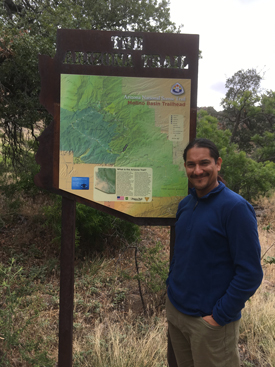
Sergio Avila is a wildlife biologist, as well as an outdoor activities coordinator with Sierra Club. (Photo: Bobby Bascomb)
BASCOMB: And Steve, Sergio has also had run-ins with the Minutemen, those are non-government volunteers who patrol the border, with guns, looking for people crossing illegally. And because they are not working in any official capacity, the Minutemen are in some ways even scarier for people like Sergio because there’s no accountability.
CURWOOD: Yeah, it kind of sounds like they’re vigilantes. So, I gather altogether he just didn’t feel safe doing fieldwork.
BASCOMB: Exactly, and Sergio is a trained field biologist with decades of experience working on endangered species in the area. Who knows what he might have found in his work that we no longer have access to? Then you extrapolate that out to the many scientists doing work in this area and it’s really a tremendous loss to science.
CURWOOD: Yeah! Right….
BASCOMB: And Sergio feels that he was especially targeted for harassment because he is Mexican-American.
AVILA: Because I have dark skin color, and black hair and an accent, I get helicopters flying over me. But if I was white, none of those things would happen to me, and so it's basically because of racial profiling.
BASCOMB: And Steve, that sentiment was backed up by another researcher that I met up with, Randy Serraglio with the Center for Biological Diversity.
SERRAGLIO: I'm a white man. So I benefit from white male privilege every day. And no, I have not been harassed by Border Patrol as much as you would think. Because really, they operate on racial profiling. So a lot of times I come up to the checkpoints, and I just get waved through. I just look like some white guy that lives in Arizona. I feel frightened sometimes on these dirt roads out here in the middle of nowhere, because every now and then you'll come across a Border Patrol vehicle driving like a maniac, you know, at high speeds. And it's very dangerous. The number one cause of death for Border Patrol agents is single-person car accidents. It’s one guy driving his vehicle too fast, and he rolls it and dies. So certainly don't want one of them to run into me, and it's come close couple times.
BASCOMB: Randy told me he doesn’t feel threatened by Border Patrol directly but he does feel afraid of ordinary citizens who don’t like his line of work.
CURWOOD: That’s right, the Center for Biological Diversity is pretty vocal in its opposition to the wall, right?
BASCOMB: Yes they are, and they also want to do things like limit cattle grazing on public lands where endangered animals live, you know, that sort of thing. Here’s Randy.
SERRAGLIO: I've done all kinds of fieldwork, right along the border on both sides, northern Mexico, southern Arizona, you know, out in those places that our government wants you to fear, and wants you to think are overrun with violent criminals and everything. And I have never felt threatened in those places. However, I do feel threatened in my office in downtown Tucson, because my organization has received death threats, you know, many times in the past because of the work that we do. And I fear that one of these days, somebody's going to walk into our office and shoot the place up. Seems to be the newest, you know, pastime in the US.
CURWOOD: So, intimidation can take a lot of forms for people working in the border areas. You mentioned earlier that there’s also another way scientists are being hampered in their work.
BASCOMB: Yeah, there is. So, another problem is that it’s becoming really difficult for scientists on either side of the border to collaborate and attend meetings together. So, for instance, there is a mountain range called the Sky Islands, I reported on one of those mountains a few weeks ago. It’s really one continuous ecosystem that goes through both the United States and Mexico. And of course, animals like jaguars that migrate through the area, they don’t know that they’re crossing an international border. So, it’s really important that conservation efforts are working in tandem, you know, so the left hand knows what the right hand is doing. And that’s what's becoming really challenging.
I spoke with the executive director of the Sky Island Alliance, Louise Misztal, about travel restrictions put in place especially for federal employees.
MISZTAL: In the last few years we have not been able to get federal agency employees, like Park Service employees have been denied travel permission to go into Mexico for meetings. And our partners in Mexico have had trouble getting visas to come into the US. So usually we're convening these binational meetings in one country or the other. And it's been nearly impossible the last few years.
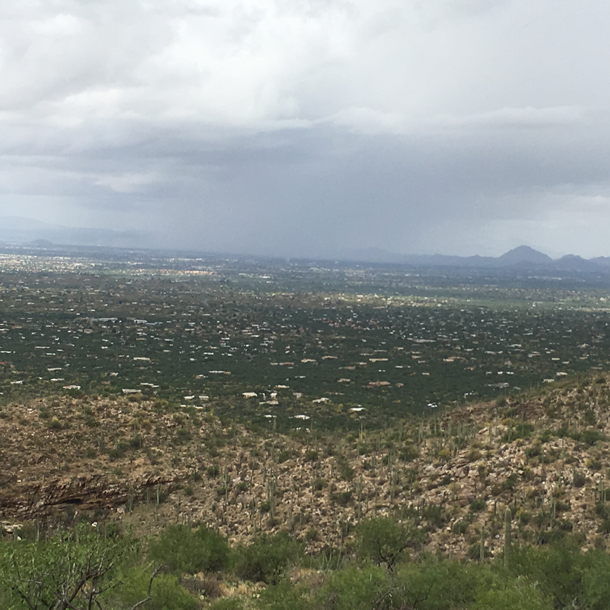
Ecosystems like the Sonoran desert are not confined to national borders, leading to complications when scientists need access to both sides of a border. (Photo: Bobby Bascomb)
BASCOMB: Now, I did confirm with another party that federal employees are generally not allowed to travel to Mexico in any official capacity. I reached out to the Interior Department for an explanation, but never got one. And I also contacted several Park Service employees in the region but none of them were willing to talk to me about restrictions on their work.
CURWOOD: Yeah, well, that’s understandable. I mean, who wants to get fired?
BASCOMB: Exactly.
CURWOOD: So, Bobby, we’ve done a number of stories in the past few years about the Trump administration and its dismissive attitude toward the value of science, and the environment in general. Everything from cutting budgets for research, to making way for oil and gas extraction on public lands. It seems that this move at the border to restrict the work of scientists, well, kind of fits in with the pattern we’ve already seen from the Trump administration.
BASCOMB: It does. In fact, the administration had to waive dozens of environmental laws to proceed with the wall expansion to begin with. That’s everything from the Clean Air Act and Safe Drinking Water Act to the Endangered Species Act. They successfully cited the 2005 Real ID Act, put in place under President Bush at the height of the war on terror, and that allows nearly any environmental law to be ignored in the name of fast-tracking a wall and barrier construction on the southern border.
CURWOOD: Oh, I see…
BASCOMB: Yeah, and then, adding to the general disregard for environmental laws and official travel restrictions put in place, just physically crossing the border has become difficult in the last few years. Here’s Louise Misztal again from the Sky Island Alliance.
MISZTAL: There's longer wait times at border crossings. Mexican staff that work with Sky Island Alliance, have had challenges and been, you know, harassed and delayed coming across the border. It’s been very challenging. And I think for some of my staff, it's kind of frightening.
BASCOMB: And I actually had a similar experience myself crossing the border. I was with a group of journalists and scientists and we were detained for an hour and a half and searched.
CURWOOD: Um, that doesn’t sound like much fun, what happened?
BASCOMB: It wasn’t. When we were asked if we had anything to declare, Gary Paul Nabhan, an agricultural professor and researcher, said, “Yes, I have a couple of small plants that I’m using for my research.” Gary identified himself as a researcher and we were traveling in a truck that said University of Arizona on the side of it. Well, that led to us being pulled aside for further inspections.
I actually recorded the first part of our detainment. First, you’ll hear the border agent and then Gary.
AGENT: It's very important that you tell me everything related to agriculture. Because if I do find something it’s subject up to to a $1,000 fine. Do you have any fruits or vegetables?
NABHAN: No.
AGENT: Do you have any plants?
BASCOMB: After some more back and forth about other items we might have in the truck, we were told to get out and wait.
AGENT: If everybody can just get down, we're gonna do a quick exam of the vehicle.
[SOUNDS OF CAR BEEPING, GETTING OUT OF THE CAR]
BASCOMB: And that quick exam of the vehicle involved going through our truck with a fine-toothed comb. I mean they took apart our suitcases, checked everyone’s pants pockets, went through our toiletry bags… everything. In the end they found a walking stick, some lemons I picked in Tucson and forgot about, and a handful of seeds in Gary’s pocket that he also didn’t realize were there. And we were charged $300 for a fine.
CURWOOD: Oh, man, what an ordeal.
BASCOMB: Yeah, and it’s becoming a common ordeal that botanists like Gary have to deal with every time they need to bring samples across the border for their work. You know, there’s a list of prohibited items that you can’t bring into the US and Gary asked for it while we were waiting but the border agents said they couldn’t give us the list because it’s constantly changing. So, if your work involves bringing samples back and forth, what are you supposed to do?
CURWOOD: In other words, catch 22, huh?
BASCOMB: Yep, exactly, and for scientists like Gary that go back and forth every week it ends up feeling like an arbitrary over-reach of authority that they just can’t plan for. He said feels like scientists and migrants entering the country are sort of treated in the same way, with an unnecessarily high degree of suspicion and distrust.
Then, add in the harassment and travel restrictions that we talked about earlier and it’s getting really hard to be a scientist on the US-Mexico border.
CURWOOD: Well, truth can be a fragile commodity.
BASCOMB: Yeah.
CURWOOD: Okay, well, thanks Bobby for your report. I’ll be looking forward to the rest of your stories from the border.
BASCOMB: Sure thing, Steve.
Related links:
- Listen to Bobby’s story about wildlife at the US-Mexico Border here
- Listen to Bobby’s story about the Coronado National Forest here
[MUSIC: Vasen, “Pa Vag” on Rule of 3, by Olov Johansson, NorthSide Records]
CURWOOD: Coming up – a new Leonardo DiCaprio documentary on climate disruption brings a message of hope. That’s just ahead on Living on Earth.
ANNOUNCER: Funding for Living on Earth comes from you, our listeners, and United Technologies, combining passion for science with engineering to create solutions designed for sustainability in aerospace, building industries, and food refrigeration. UTC companies such as Otis, Carrier, Pratt and Whitney, and UTC Aerospace systems are helping to move the world forward. You can learn more about United Technologies by tuning into the Race to Nine Billion podcast; listen at racetoninebillion.com. This is PRI, Public Radio International.
[CUTAWAY MUSIC: Symon Wynberg, “Mariah’s Watermill” on Guitar Works, Narada Lotus]
HBO’s “Ice on Fire” Offers Climate Solutions
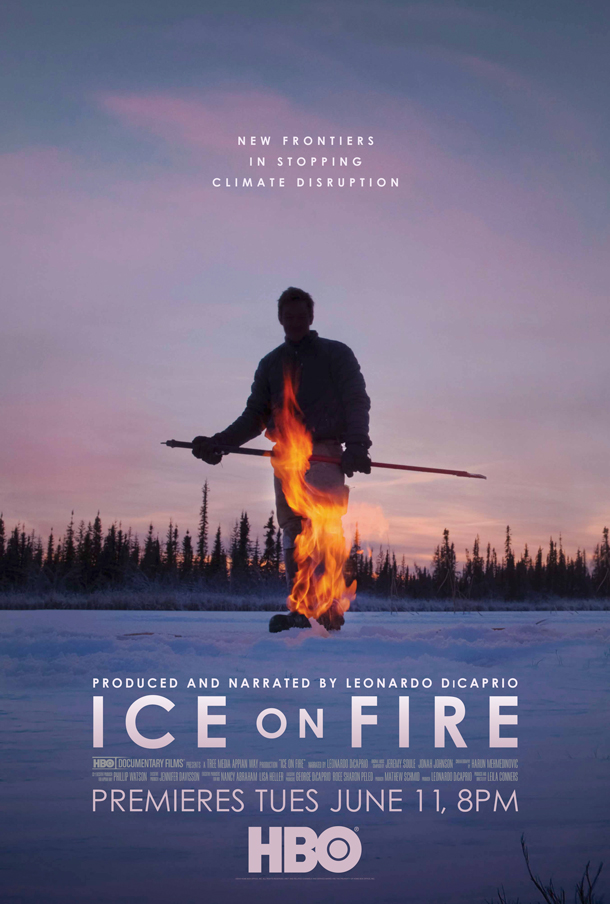
Ice on Fire is available for free through HBO. (Photo: Courtesy of HBO)
CURWOOD: It’s Living on Earth, I’m Steve Curwood.
[EXPLOSION SOUND]
CURWOOD: You might think you’re hearing a jet engine, but it’s actually methane leaking from the melting tundra in the Siberan Arctic that’s been set on fire. This ominous sign of global warming is also the title of a new documentary about climate change, narrated by Hollywood movie star Leonardo DiCaprio. In contrast to many climate documentaries, Ice on Fire not only issues a dire warning, but it also seeks to inspire people to follow proven, safe, and sustainable pathways available right now that can reverse global warming. Leila Conners directed and edited Ice on Fire, and we’ll speak with her shortly, but first here’s a preview of her documentary, which you can watch for free, simply by going to the HBO website.
[FILM MUSIC]
DICAPRIO: Over the last 250 years we have in effect conducted the largest science experiment in history. The melting of the world’s snow and ice has now triggered multiple climate tipping points, threatening the very existence of life on earth. Yet this disturbing future need not be set in stone. But the clock is ticking. Scientists say we must implement these solutions immediately.
BENYUS: These natural disasters are so common now that people know it’s going to happen to their community. It's not a matter of if but when. It is a wake-up call to everyone that climate change is here and that you need to plan for it.
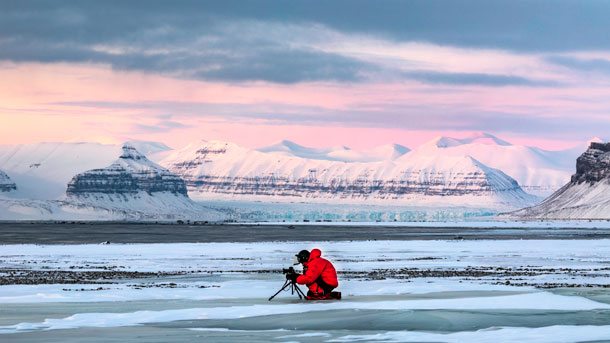
Ice on Fire took two years to make and features scenes taken from around the globe. (Photo: Courtesy of HBO)
MANN: In short you're looking at a world with less food, less water, and more people. And that's a recipe for a national security disaster.
DICAPRIO: Science tells us that our current climate crisis is a problem we’ve created. But it is also a problem we can fix. Climate change can be reversed if we act now.
BENYUS: Climate change gives us an opportunity to really behave differently on this planet. We see what we can do at our worst, and now the question is, if we were to consciously be a part of the healing it will unleash, I think, our creativity. You realize, oh my gosh, I have a backyard. Oh my gosh, I have a park near me. If we were to see ourselves as helpers, who could help the helpers heal the planet, that is so much better than seeing ourselves as disruptive toddlers with matches. You begin to realize that all of us are somehow connected to little bits of the solutions.
HAWKEN: Where do we stand? Is it possible? Is it game over, or is it, in fact, game on? Which is, we have, at hand, the ability, capacity, and solutions, that can reverse global warming...not mitigate, not reduce, not stabilize, but reverse…
DICAPRIO: We are the first generation to see the advance of climate disruption and the last with a chance to fix it. It is time to end the delay, to listen and to implement the solutions at hand. Time is running out. The ice is melting. Decisive action must be taken now. There is no other option. This moment is within our reach, let us grasp it. It is up to us, each one of us, to save this unique blue planet for generations to come.
[FILM MUSIC]
CURWOOD: We just heard excerpts from the documentary Ice on Fire, narrated by Leonardo DiCaprio and directed and edited by Leila Conners. Leila joins us now from Santa Monica to talk more about the film, available for free now on HBO. Thanks for joining us, Leila!
CONNERS: Hello, and thanks for having me.
CURWOOD: Describe for us the opening scene, we're looking from a drone and we see?...
CONNERS: A snowcat climbing the mountain. And, we're not sure where we're going quite yet, but we see a female driving the snowcat in a blizzard white out. And, the first thing we finally hear is she says, you know, we have to come up here every Tuesday to collect the sample. And, you're thinking, what is that and all of a sudden, she pulls up to the shack in the middle of this mountain. We're at 11,000 feet, there's wind blowing, it's very cold. And, basically, she goes inside, and she pulls gas out of the air and into these canisters. And what she's doing is taking the weekly measurement of the atmosphere. And we find that this is how we've known about the carbon in the atmosphere for the last 50 years. And in fact, we were there on the 50th anniversary of sample taking that very day, and then we didn't even plan it was just coincidence. So, NOAA, the National Oceanic and Atmospheric Administration has been conducting these sample tests for 50 years in the same locations every week. And they also do it in 60 places around the world. For example, in Mongolia, there's a woman that takes these canisters and takes a train ride for 10 hours, and goes up a mountain to take the sample and come back. So, these are dedicated people, everyday people with science backgrounds that helped take the samples, and they're all sent back to NOAA in Boulder, Colorado for measurement. So, the reason why we started the movie like this is that we really wanted to say, look, you know, this is, this is a person that you and I can recognize. A hardworking person. And these are not liars. These are people who are gathering the data, gathering the evidence, so that when we say carbon’s in the atmosphere, this is not a debate. It's like taking your temperature, right? And, we go on to explain later that, you know, the carbon that they're measuring, is specific to fossil fuel burning. So it’s C-13 carbon, natural carbon is C-14. And so they know exactly that it's human caused, it's never been a question.

Fossil fuel burning is one of the leading causes of excess CO2 in our atmosphere. (Photo: Courtesy of HBO)
CURWOOD: And, of course, when you mean by C-13, is a carbon that's been sequestered in the earth for millions of years is no longer radioactive. And, the stuff that's out with us right now does have a little bit of radioactivity.
CONNERS: Precisely.
CURWOOD: Now, you and Leonardo DiCaprio have collaborated in the past, you did The 11th Hour back, what, in 2007? You were a codirector on that doc, what inspired you and your team to make this film?
CONNERS: Well, as you know, things have not improved. And, we were very, very concerned about... Leonardo specifically, was concerned about methane, and what was happening in the Arctic, and the spike in methane readings in the atmosphere. So, he wanted us to investigate that, and let people know about it, because as you know, it's a tipping point that we don't want to cross. And, alongside that, as you know, there's also innovation coming online, as well as more knowledge about how nature works. So, we just felt that there were a lot of new things that were occurring that we did not see in the general press. So, therefore, we decided to make the film!
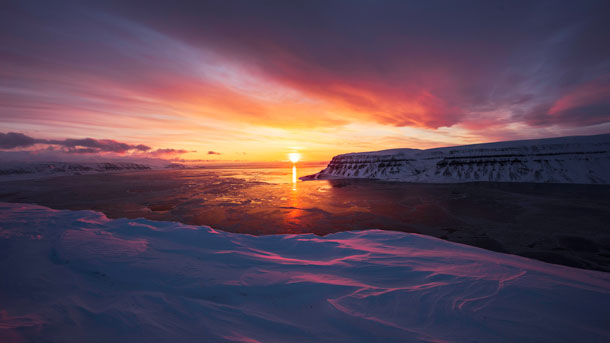
Ice on Fire earnestly attempts to persuade its audience that if they take action now then climate change can not only be halted, but reversed. (Photo: Courtesy of HBO)
CURWOOD: Your film is huge. You cover a lot of territory, you cover a lot of things. You yourself personally, were there in the editing booth to make it all come together. At the end of the day, who are you trying to get to with this movie? Who are you trying to reach?
CONNERS: We're trying to reach people that are ready to step into this transformation. And, we know that could be almost anybody. We also know that there are people that are able to step into creating community gardens, step into planting trees, step into innovating, those were our primary targets. But, we also wanted to reach everyone through the beauty of it. And, that's what we concentrated on. We also had this idea that we wanted to show people the world from a human level. So, a lot of climate docs, and I've done a few, have very distant vantage points, often. Satellites, and very high, distant. And we flew the drone, purposely at the level of a human being, at the height of human being. So, it was really bringing people into the world into the spaces where we were. And we felt that if we did that, and if we talked to people that work every day on this, that it would have more connectivity. And we're actually finding that that's actually the case, it is connecting.
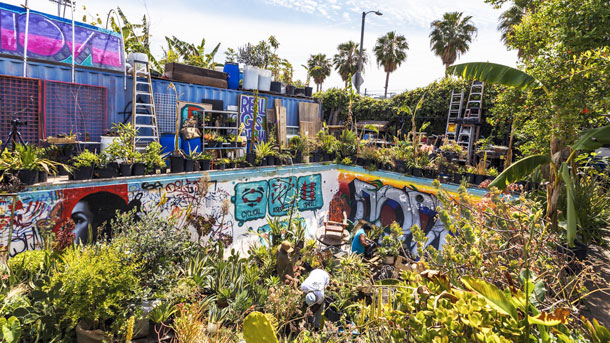
Urban farming is a great way to capture CO2 while creating healthy foods for a community. (Photo: Courtesy of HBO)
CURWOOD: So, what I'm hearing, you perhaps say, is that for folks who have a level of concern, who have some familiarity to this, that this is a shorthand guidebook for them to look at the possibilities, as well as the problems.
CONNERS: That's exactly it. It's sort of the update, it's like, here's where we're at. And, also, here's how the world works. And, this is how you can plug into it. I think when you diagnose a problem more completely, people can naturally step into the solution on their own, they don't need to be told what to do, they can see it. So, what we tried to do is say, look, the carbon cycle is really the problem here. Because what we've done is disrupt the carbon cycle with fossil fuels. And, so, once people understand that, in the film we explain how it works, we understand oh, okay, well, we can remove carbon from the atmosphere. You know, nature is our first line of defense, and also innovate and find other ways to do it.
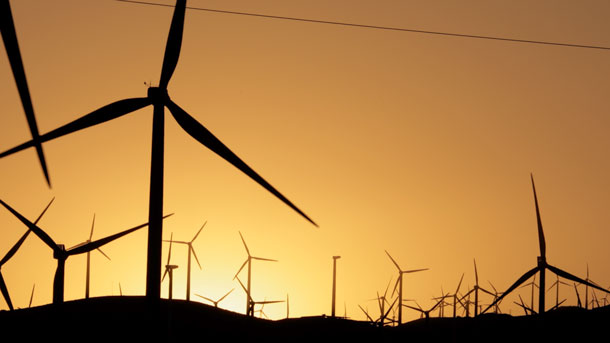
Renewable energy, such as wind power, has been in existence for a long time. Ice on Fire urges their audience to further implement these renewables to halt climate change. (Photo: Courtesy of HBO)
CURWOOD: Tell me about the scene where you show these carbon sequestering machines. They're big, shiny things with pipes, and they're making what? Coal, they're making diamonds, what are they doing?
CONNERS: They're making basalt rock in Iceland. So, basically, these carbon sequestering machines are made in shipping containers, just take a shipping container, put these pieces inside. So, it sucks atmospheric carbon out of the air, and then you can use it for stuff. Now, obviously, we need to turn some of it into stone. And, that's what they're doing in Iceland, so that it never comes back up again. You can also use the carbon from the sky to turn it into fuel. So, interestingly, direct air capture basically disrupts the fossil fuel industry. So right now, the fossil fuel industry is going around the world digging up stuff, you know, fracking and drilling. And that's just old news, now. You just have this little tiny machine, you can pull it out of the sky. Obviously, that is not reversing the load in the atmosphere, but at least it's not adding to it. So, you know, it's something else that I've been talking about where you know, people are innovating, people are declaring a climate emergency. And I'm very excited about that movement, and Sunrise Movement and Extinction Rebellion, all this stuff. I mean, you really feel people are rising to the occasion. And a lot of climate scientists look at direct capture and say this is something very passive, it's reversing something that we've done. So yeah, a lot of climate scientists, as you see in the film, actually support it.
CURWOOD: It's very interesting in your film, you are quite subtle about making the point that keeping the rise to one and a half degrees Centigrade is just the beginning of the long term game for humanity. Because we have to draw carbon back down even further so that we can refreeze the Arctic, and have the ecosystems that people used to live in, here on the planet.
CONNERS: Well, yes, and I think what we're coming to understand, and that's why we had Daniel Rothman from MIT in the film, he's been studying carbon cycles over millions of years. And, as he said in the movie, you know, when carbon dramatically spikes in the atmosphere, the web of life collapses. And, so we have the Permian mass extinction, the PTM. And all of those, there's five mass extinctions that they have studied that all have the same signature of a high spike in carbon. So, what we need to do, you know, is draw that carbon down, like we said. 1.5 is the limit, where we are now as little over one, and that is result of the 400 parts per million. And like Jim White says, we're headed to 600 parts per million. That is just an untenable situation. I mean, that melts all the ice in the world. And that's happened in the past, in terms of other ages. I mean, there has been times where there has been no ice on the planet, but humans didn't live at that time.
CURWOOD: [LAUGHS] No. So, tell me about one of your most inspiring moments for you, when you were out on location.
CONNERS: The most inspiring thing was consistent across a lot of what we did, which was the earnestness within which these people do their work. And I think that's what comes across. I think that the hope that everyone's searching for, if you want hope, just go talk to the people that are dealing with this problem, because they're actively taking this on every day. And it gives you a sense of purpose and purchase on this. And that, to me is very, very heartwarming and inspiring.
CURWOOD: So, what was one of the most disheartening things that you encountered?
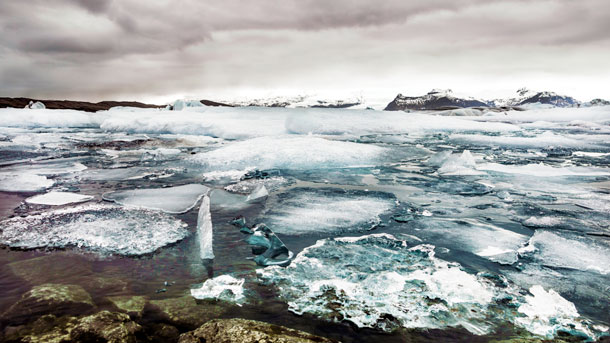
Ice is melting at record rates, causing sea level rise. (Photo: Courtesy of HBO)
CONNERS: The sound of the dripping of the glacier in Iceland was the most haunting, and I still hear it in my mind. And, basically, when you're standing next to a glacier that's melting, like that, it's the sound of millions of tiny drops. So, it's not this crash and bang and whoosh. And, I'm sure it is that way, in some places. But, on a day to day basis, if you're standing next to a melting glacier, it’s just millions of tiny little drops that are adding up to a little river that adds up to a wider river. And, that's the sound of the end of that glacier. And, that to me is horrifying.
CURWOOD: What some call the tears of the Arctic.
CONNERS: Yeah.
CURWOOD: Leila, how hopeful are you? What are the odds of our civilization, utilizing the solutions that you talked about quickly enough to turn things around before we wind up with the hot house earth?
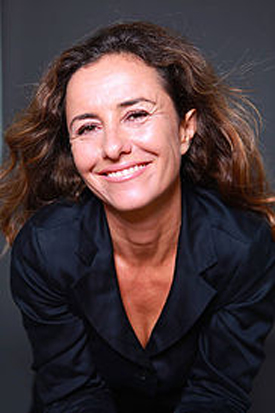
Leila Conners is the editor and director of the documentary film Ice on Fire. (Photo: Courtesy of HBO)
CONNERS: I think I'm hopeful because we actually have the solutions at hand. It's not a problem that we don't know the answer for. We have the answer. We just have to do it. And, so that's why the denial industry in the United States is so lethal, because it's slowing us down. We have to move on from fossil fuels and really, you know, mobilize to pull carbon out of the sky and stop putting carbon up into the sky. And I think we can because we have the solutions.
CURWOOD: Leila Connors is the director and editor of the documentary film, Ice on Fire. Thanks so much for taking the time with us today, Leila.
CONNERS: Thank you.
Related links:
- Watch "Ice on Fire" for free here
- Learn more about Leila Conners’ other work here
[MUSIC: Jeremy Soule, The Streets of Whiterun (Skyrim)]
CURWOOD Living on Earth is produced by the World Media Foundation. Our crew includes Naomi Arenberg, Diego Arenas, Bobby Bascomb, Paloma Beltran, Thurston Briscoe, Jenni Doering, Jay Feinstein, Merlin Haxhiymeri, Don Lyman, Lizz Malloy, Aynsley O’Neill, Jake Rego, and Jolanda Omari. Tom Tiger engineered our show. Alison Lirish Dean composed our themes. We bid farewell to our intern Joseph Winters this week -- best of luck on your bee research this summer, Joseph! You can hear us anytime at LOE.org, iTunes and Google Play- and like us, please, on our Facebook page - PRI’s Living on Earth. We tweet from @livingonearth. And you can find us on Instagram at livingonearthradio. I’m Steve Curwood. Thanks for listening!
ANNOUNCER: Funding for Living on Earth comes from you, our listeners, and from the University of Massachusetts, Boston, in association with its School for the Environment, developing the next generation of environmental leaders. And from the Grantham Foundation for the protection of the environment, supporting strategic communications and collaboration in solving the world’s most pressing environmental problems. Support also comes from the Energy Foundation, serving the public interest by helping to build a strong, clean, energy economy and from Carl and Judy Ferenbach of Boston, Massachusetts.
ANNOUNCER 2: PRI, Public Radio International.
Living on Earth wants to hear from you!
Living on Earth
62 Calef Highway, Suite 212
Lee, NH 03861
Telephone: 617-287-4121
E-mail: comments@loe.org
Newsletter [Click here]
Donate to Living on Earth!
Living on Earth is an independent media program and relies entirely on contributions from listeners and institutions supporting public service. Please donate now to preserve an independent environmental voice.
NewsletterLiving on Earth offers a weekly delivery of the show's rundown to your mailbox. Sign up for our newsletter today!
 Sailors For The Sea: Be the change you want to sea.
Sailors For The Sea: Be the change you want to sea.
 The Grantham Foundation for the Protection of the Environment: Committed to protecting and improving the health of the global environment.
The Grantham Foundation for the Protection of the Environment: Committed to protecting and improving the health of the global environment.
 Contribute to Living on Earth and receive, as our gift to you, an archival print of one of Mark Seth Lender's extraordinary wildlife photographs. Follow the link to see Mark's current collection of photographs.
Contribute to Living on Earth and receive, as our gift to you, an archival print of one of Mark Seth Lender's extraordinary wildlife photographs. Follow the link to see Mark's current collection of photographs.
 Buy a signed copy of Mark Seth Lender's book Smeagull the Seagull & support Living on Earth
Buy a signed copy of Mark Seth Lender's book Smeagull the Seagull & support Living on Earth

